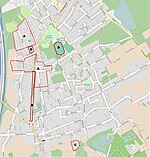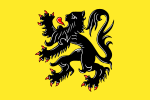Flanders (UK: , US: ; Dutch: Vlaanderen [ˈvlaːndərə(n)] ) is the Dutch-speaking northern portion of Belgium and one of the communities, regions and language areas of Belgium. However, there are several overlapping definitions, including ones related to culture, language, politics, and history, and sometimes involving neighbouring countries. The demonym associated with Flanders is Fleming, while the corresponding adjective is Flemish, which can also refer to the collective of Dutch dialects spoken in that area (or, less commonly, the Belgian variant of Standard Dutch). The official capital of Flanders is the City of Brussels, although the Brussels-Capital Region that includes it has an independent regional government. The powers of the government of Flanders consist, among others, of economic affairs in the Flemish Region and the community aspects of Flanders life in Brussels, such as Flemish culture and education.Geographically, Flanders is mainly flat, and has a small section of coast on the North Sea. It borders the French department of Nord to the south-west near the coast, the Dutch provinces of Zeeland, North Brabant and Limburg to the north and east, and the Walloon provinces of Hainaut, Walloon Brabant and Liège to the south. Despite accounting for only 45% of Belgium's territory, more than half the population lives there – 6,653,062 (or 57%) out of 11,431,406 Belgian inhabitants. Much of Flanders is agriculturally fertile and densely populated at 483/km2 (1,250/sq mi). The Brussels Region is an officially bilingual enclave within the Flemish Region. Flanders also has exclaves of its own: Voeren in the east is between Wallonia and the Netherlands and Baarle-Hertog in the north consists of 22 exclaves surrounded by the Netherlands. Not including Brussels, there are five present-day Flemish provinces: Antwerp, East Flanders, Flemish Brabant, Limburg and West Flanders. The official language is Dutch.
The area of today's Flanders has figured prominently in European history since the Middle Ages. The original County of Flanders stretched around AD 900 from the Strait of Dover to the Scheldt estuary and expanded from there. This county also still corresponds roughly with the modern-day Belgian provinces of West Flanders and East Flanders, along with neighbouring parts of France and the Netherlands. In this period, cities such as Ghent and Bruges of the historic County of Flanders, and later Antwerp of the Duchy of Brabant made it one of the richest and most urbanised parts of Europe, trading, and weaving the wool of neighbouring lands into cloth for both domestic use and export. As a consequence, a very sophisticated culture developed, with impressive achievements in the arts and architecture, rivaling those of northern Italy.
Belgium was one of the centres of the 19th-century Industrial Revolution, but this occurred mainly in French-speaking Wallonia. In the second half of the 20th century, and due to massive national investments in port infrastructure, Flanders' economy modernised rapidly, and today Flanders and Brussels are much wealthier than Wallonia, being among the wealthiest regions in Europe and the world. In accordance with late 20th century Belgian state reforms, Flanders was made into two political entities: the Flemish Region (Dutch: Vlaams Gewest) and the Flemish Community (Dutch: Vlaamse Gemeenschap). These entities were merged, although geographically the Flemish Community, which has a broader cultural mandate, covers Brussels, whereas the Flemish Region does not.








